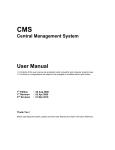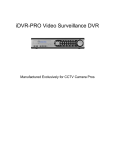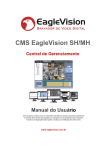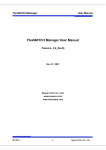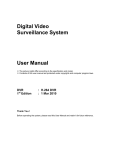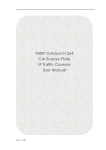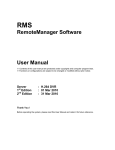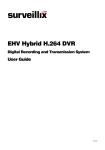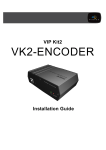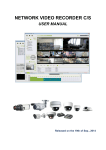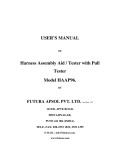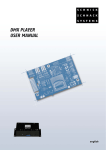Download DiSS EM-4000 Series User Manual
Transcript
CMS Central Management System User Manual Edition : 20 Aug 2008 Thank You Thank you for purchasing ! Before operating the system, please read this User Manual thoroughly and retain it for future reference. ※ Contents of this user manual are protected under copyrights and computer program laws. Contents 1. INTRODUCTION ........................................................................................................................................................................... 1 1.1 1.2 1.3 SYSTEM REQUIREMENT ................................................................................................................................................................ 1 SYSTEM CONFIGURATION............................................................................................................................................................. 1 MENU STRUCTURE ....................................................................................................................................................................... 2 2. INSTALLATION............................................................................................................................................................................. 3 3. INITIAL SETTING ......................................................................................................................................................................... 4 3.1 3.2 3.3 3.4 4. SYSTEM STARTUP ......................................................................................................................................................................... 4 SITE REGISTRATION ...................................................................................................................................................................... 4 E-MAP REGISTRATION.................................................................................................................................................................. 7 OPTION ......................................................................................................................................................................................... 8 SYSTEM MONITORING ............................................................................................................................................................ 12 4.1 4.2 4.3 4.4 5. MONITORING .............................................................................................................................................................................. 12 REMOTE LOG VIEWER ................................................................................................................................................................ 14 SYSTEM UPGRADE ...................................................................................................................................................................... 15 DATA BACKUP ............................................................................................................................................................................ 15 IMAGE MONITORING ............................................................................................................................................................... 17 5.1 5.2 5.3 6. DRAG & DROP CONNECTION ..................................................................................................................................................... 17 OPEN NEW WINDOW ( SUB-MENU CONTROL ).......................................................................................................................... 18 CONTROL PANEL......................................................................................................................................................................... 20 E-MAP ........................................................................................................................................................................................... 27 6.1 6.2 7. E-MAP EDITOR .......................................................................................................................................................................... 27 E-MAP MANAGEMENT .............................................................................................................................................................. 30 REMOTE CONFIGURATION.................................................................................................................................................... 32 7.1 7.2 7.3 7.4 8. WEB LOGIN ................................................................................................................................................................................ 32 WEB CONFIGURATION ................................................................................................................................................................ 33 WEB MONITORING ..................................................................................................................................................................... 34 WEB PLAYBACK ......................................................................................................................................................................... 34 UTILITY FUNCTION................................................................................................................................................................... 35 8.1 8.2 8.3 EVENT VIEWER ........................................................................................................................................................................... 35 INTELLI-SEARCH ........................................................................................................................................................................ 35 FILE SEARCH .............................................................................................................................................................................. 35 9. EVENT SERVER......................................................................................................................................................................... 36 10. SPECIFICATION ......................................................................................................................................................................... 37 1 1. Introduction CMS (Central Management System) is a powerful centralized management solution that offers user full flexibility to control the entire system over the network, and consists of 4 functional modules, System Monitoring, Image Display, E-Map and System Configuration. User can set automatic backup schedule for effective handling of massive volume of video data, and also get the full monitoring on system status such as system temperature, CPU burden, network bandwidth in usage, etc,… 1.1 System Requirement [Recommended Specification] Classification Specification OS CPU RAM VGA HDD Windows XP and Vista Intel Core2 DUO 2.4 and Over 2 GB Min 256 MB Min 30 MB Min [Minimum Specification] 1.2 Classification Specification OS CPU RAM VGA HDD Windows XP and Vista Intel Pentium IV 3.0 and Over 1 GB Min 128 MB Min 30 MB Min System Configuration 2 1.3 Menu Structure Configuration Site Registration E-Map Registration Option Setting Main Menu System Monitoring System Monitoring Remote Log Viewer System Upgrade Schedule Backup Video Monitoring Display Mode Control Panel Additional Function E-Map Management E-Map Display E-Map Editor Remote Configuration Web Configuration Web Monitoring Web Playback Utility Function Event Viewer Intelli-Search File Search Event Server 3 2. Installation User can find “CMSSetpup.exe” file in CD and click it to start the installation of CMS software. User can easily set up this program by InstallShield Wizard as below, which is for user to simply click “next” buttons. Upon clicking “Finish” button as above, user can find the icon of “CMS” installation, user can click this icon to execute CMS software. Note created on desktop window. After initial CMS program is located in “C:\Program Files\CMS” as default unless user changes its folder during program installation. 4 3. Initial Setting 3.1 System Startup Click the CMS icon on desktop window or “Central Management System” of MS Windows’ “Start” menu to get the CMS Login window as below. Input the correct “User ID” and “Password” in the login box, then, CMS software will be executed. The default password for “Administrator” is none, leaving it empty in “Password”. Note 3.2 Program Information User can get the CMS version information by clicking “?” icon on the top-right corner of main window. Site Registration st This is to register the relevant products such as DVR, IP camera and IP server in this CMS software, which is the 1 step to run the program. Click the “Site Registration” ( ) icon on the top-left corner of main window to get the “Site Registration” window. User can newly register DVR or modify existing DVR information in this window. 5 Click “Device Search” button on the “Site Registration” window to get “”Device Detection” table as below, and then click again “Search” button on the “Device Detection” table to get the full list of the connected devices on the same network environment. User can find all the devices detected by CMS in “Device Detection” table as above. In this table, user is able to obtain those device information such as Status, Device Name, Version Information, Network Type, IP Address, Mac Address, Subnet Mask, Gateway, and Result. Note Those devices listed up in this “Device Detection” table must be in the same network environment, which means to be connected by the same network router in LAN condition. Upon clicking “IP Setting”, user can easily change an IP address of a selected device over the network. Once user lists up all the unregistered devices in the table, user can select a certain device to be registered in the CMS by mouse click on “Site Registration”. User can select a group to include this site, change site name, IP address, or change password and so on whichever is available in this menu window. In other way, user can simply click on “Unregistered Device” on the left tree window to list up all the devices that are detected on the same network condition but not yet registered by user. 6 When user selects a certain device in the list, then user can click the right button of the mouse to pop up a sub-menu to refresh the list, register device or set up network information. User can create, delete, change, or move a group in “Group Management” of “Site Registration” menu. In order to move group location, user can click up/down arrow button in right side of the menu window. In order to create a new group, delete an existing group, or change the name of group, user can click “Add/Modify/Delete” buttons in the bottom of the “Group Management” menu window as below. 7 In order to move a location of a registered device up and down, user can click “up/down” arrow button after user once positions a mouse pointer among registered devices in a certain group. User can also delete, add or modify a registered device in “Site Registration” menu once after user selects a certain registered device in left window. 3.3 E-Map Registration This is to register an E-Map file. User can click “E-Map Registration” icon ( ). User can select an E-Map file to be registered in this CMS S/W in “XML” format by a mouse click on “Open” of this sub menu window, after user make E-Map file in E-Map editor. User can tick “Preview” to see the map image in advance before opening it. 8 Note 3.4 When user saves E-Map file in “E-Map Editor”, this E-Map file is saved in XML format in order to contain map image, and various icon information. Option User can select a variety of options for CMS in this menu by a mouse click on “Option” ( ). There are 5 kinds of options ; Play, Network, Event, CMS and User. 3.4.1. Play In particular for live backup, user can select “SSF”, or “AVI” file format for live video archiving into local CMS PC. When user select “SSF” file format, there must be a relevant player program such as CMS, RMS or BKPlayer.exe in order to retrieve the SSF backup file. 9 Note There must be a relevant codec in order to retrieve AVI backup file through WindowMedia or corresponding playback program for AVI. 3.4.2. Network The domain name of DDNS server that is “cctv-link.net” is a fixed domain name for embedded DVR. User does not need to change this domain name and port number unless user has to add other type of device. Time synchronization server is the IP address of CMS PC itself. Once user enables this “Time sync Server”, then the time of all the connected devices should be automatically synchronized by the time of this CMS PC. Note “Time sync server” means the CMS PC itself. 3.4.3. Event This is to be alerted by CMS program when there is an event occurred in the DVR connected over the network. User has to check out the DVR first how it’s been set in “Remote Notification” menu of the DVR. 10 Note A live video will be popped up in single channel screen upon event creation if user ticks in “Automatically connects sensor occurrence sites”. In this case, the device shall be registered first. 3.4.4. CMS This is about interval time for system checking and log data set-up. User is recommended to tick “Regular System Check” in order to keep updating the registered device status so that user can always monitor the latest device status information for such as dynamic IP address, recording status, event information and so on. 3.4.5. User User can define the function authority for each user group ; Administrator, Manager, User and Guest in this option. 11 In user permission setup, click “User Level Function” to open “User Function Setup” menu. User is able to implement each function to different user group in order to define the authority of each user group ; administrator, manager, user and guest. Once user makes “User Permission Setup”, then user can add a new user, delete or modify the existing user in “User Add/Remove” menu. 12 4. System Monitoring CMS is to help system administrators to effectively manage a large number of cameras connected from many digital video recorders over network. CMS is consisted of 4 different modules ; System Monitoring, Image Display, E-map and System Configuration. The section of “System Monitoring” is consisted of 4 feature ; monitoring, remote log viewer, system upgrade, and schedule backup. 4.1 Monitoring In this “’Monitoring” section, user can collect all the information available supported by the device over the network for such as site name, IP address, model name, Log-in user, CPU in load, HDD in use, system memory, number of network connection user, network bandwidth in use, and record period. All these information is to be listed up in right window as below when user clicks on the name of each group or “Registered Device” in left window. For more details in individual device, user has to click the name of each device to collect those information as video, audio, sensor, relay, recording mode, resolution, recording frame(FPS), HDD, system, device, version, dynamic, device information, and so on. 13 Note For full compatibility of device information collection, user has to make sure that the device has the right & latest firmware supporting CMS. st 1 section of “System Monitoring” by a specific device site is to show up all the camera status information ; camera, sensor, relay, recording mode, recording resolution, and audio on/off by camera by camera. User can check out if a certain camera is recording or not recording, sensor is triggered or not, what recording mode is each camera, which resolutions (CIF/2CIF/D1) is being recorded, or audio is on or off at sight. nd The 2 section of “System Monitoring” is to show up all the HDDs information installed in DVR. User can instantly learn the HDD capacity in size each, space used in percentage, temperature, and HDD format type in below table. rd The 3 section of “System Monitoring” is system information. This is to give general system information on CPU type, CPU speed, system memory, MAC Address, and device type. th The 4 section of “System Monitoring” is version information in H/W and S/W. User can easily check out what version is in S/W and H/W by which model name. 14 th The 5 section of “System Monitoring” is network information for the device connected to CMS. The last section of “System Monitoring” is general device information. Device could be digital video recorder, video streamer or IP camera connected to the CMS. This section shows video signal, codec for both video & audio, number of cameras, sensors, relay, audio and network connection as well as network bandwidth in occupation by the device itself. 4.2 Remote Log Viewer User can collect all the event and system-related log lists by date in this section. There are total 4 different kinds of log information ; system, event, setting, and network. 15 4.3 System Upgrade “System Upgrade” feature helps administrator easily upgrade all or selected devices with new firmware by one-click over network. User can click “Folder” to match the correct firmware file and click “Upgrade” button to execute upgrading after user select the device. User is required to check the current S/W and H/W version listed in the table before upgrading. 4.4 Data Backup “Data Backup” enables administrator to archive video & audio data over the network dragging the data from devices selected. User can pre-define the backup execution schedule and backup data period for each device in this menu. If user ticks “Continuous Archive”, then the CMS is to archive all the data recorded by the selected device on network up to present into CMS server. 16 “Archiving Execution Time” means that the CMS starts archiving by the pre-defined time schedule in this section on the date selected in “Backup Interval”. Note User has to make sure of securing enough network bandwidth for such a massive amount of data backup on network. This network backup is valid in LAN condition. 17 5. Image Monitoring This window is to mainly get users live monitoring and playback in each independent camera channel on the window of maximum 36 channel basis. 5.1 Drag & Drop Connection User can simply drag & drop by mouse to open video in empty channel for both live and playback. Once after selecting either “Live” or “Playback” in the left-side sub-menu, user can select & drag an individual video channel or entire video group and then drop them into an empty channel that user wants to monitor or play. When it is playback mode, user can find time video-bar in different colors by recording modes in “Intelli-Search”. User can reposition the vertical time bar with mouse control to move forward and backward for different time search. Or, user can select a certain date in calendar and then drag & drop a video channel or entire device to playback. 18 On playback mode, user can adjust time interval of Intelli-Search bar for more effective image search by clicking “Intelli search” button. Note 5.2 User has to make sure of opening “Intelli-Search” in the bottom of the main screen, and tick “Playback” in the right side of the main screen in order to retrieve VOD. Open New Window ( Sub-Menu Control ) Sub-menu is created by click of mouse right button as below. User can create another 36channel window in sub-menu by mouse click on “Open in new window”. This creation enables user to get multiple windows up to total 4 different new windows that is each maximum 36channels per window, which is useful in surveillance via multiple monitors. User can move this new window to other monitor by mouse if user has multiple monitors. 19 Or, user can spread all the windows in single monitor by mouse click on “ ” in the right top corner of the window screen. ) in the top right corner of the window. If user wants to have full screen mode, then user can click the quad-arrow icon ( To get back to the original mode, then user can hit “ESC” key of the P/C keyboard. User can install multiple monitors by moving a new monitoring window to other monitors by mouse dragging. 20 Note For multi-monitor connection, user has to connect them via VGA distributor connected to the CMS server. Note Cascade-screen mode is for multi-monitoring purpose via multiple monitors at the same time, whereas full-screen mode is for single-monitoring purpose via a large-sized PDP/LCD monitor. Note Theoretically, CMS program supports up to 180 channel monitoring at the same time. However, key conditions for maximum number of channel support are rather dependent on PC & network resources than the program itself. 5.3 Control Panel User is able to fully control the connected video channels in this control panel located in the right side of the main window for such as screen mode, playback, backup, printing, relay, sensor, PTZ, image filtering, and so on. 5.3.1. Connection User can select “Live” or “Playback” mode before video connection. When user wants to switch live video to playback mode, then choose “Playback” in right side and “Intelli-Search” in the bottom of the main screen. Then, drag a selected video channel and drop it into the same or empty channel. 21 Or, user can open the sub-menu panel by right buttons of the mouse click, and choose “Go to live” or “Go to playback” menu, and “Intelli-Search” in the bottom before drag & drop channels. Note 5.3.2. User has to newly drag & drop channel again if he/she wants to switch “live” to “playback” or vice versa. Information User can get some useful video & audio-related information in this section. By scrolling down, user can find average transmission frame speed, average bit rate in Kbps, Site name, IP address, camera channel number, video type, recording resolution, audio sampling rate, and audio codec. Note 5.3.3. Average bit rate is calculated in Kbps. User has to divide this bit rate by 8 bit and by average FPS to get average file size in frame. Play User can select screen mode ; single, 4, 9, 13, 16,21, 24, and 36-split screen mode. “Play Speed” buttons become valid in playback video mode when user selects a VOD channel. “Synchronize all the channels” is multi-channel playback in time synchronization when user moves the red-colored vertical time bar in “Intelli-Search” menu. User has to tick this “Synchronize all the channels” in order to play multiple channels at the same time. 22 Unless ticking this “Synchronize all the channels”, only single video channel in mouse selection would be played only even though user moves the red time bar in “Intelli-Search” menu. Note User has to tick “Synchronize all the channels” in order to play multiple video channels at the same time when user moves the red-colored vertical time bar in “Intelli-Search”. The camera icon ( ) is to instantly make a still-image backup file in JPG or BMP as user set in option in advance. User can change the saving directory (folder) or still-image format in Play Option of CMS. Upon click on this camera icon, a still-image is saved in the name of date & time that the image was recorded by DVR for playback or captured by CMS for live image. For example, if the file name is “20080515113949AM.jpg”, it means that this still-image was recorded at 11:39 and 49 th second in the morning (AM) on May 15 , 2008. The first 4 digits mean “Year”, the next 2 digits are “Month”, the next 2 digits are “Day”, the next 2 digits are “Time/Hour”, the next 2 digits are “Time/Minute”, the next 2 digits are “Time/Second”, and the last 2 digits are AM or PM. ) is to zoom-in and zoom-out image in the selected video channel at either The icon of magnifying glass ( still-image(Pause) or motion video(Play or Live). User can zoom-in upon click on the right button of mouse, or zoom-out upon click on the left button of mouse. User can leave zoom-in image once he/she click this magnifying icon again. 23 The printer icon ( ) is to instantly print out by paper or PDF for the captured image. The image size in print will be shown as the original recorded/transferred resolution ; 1CIF, 2CIF or 4CIF/D1. There must be a recording information for such as recording date, time, channel number and camera title along with the original captured image. The film icon ( ) is to instantly record live video into the local PC where CMS is installed. User can select this backup file format by either “SSF” or “AVI” at the Option menu of the CMS. Typical folder directory where these video clips are saved is “ArchiveData” of CMS of Program Files at C:\. Or, user can change this folder directory at the Option menu of CMS. To play this video clip in AVI format, user can retrieve it by ordinary Windows Media Player by simply clicking the file name. Note This “Local file save” function is available in “Live” monitoring mode only. Note This AVI format is playable by Windows Media Player at the PC that has a necessary codec, named “Xvid”. Contact vender or manufacturer if user’s PC does not have this Xvid codec. To play this video clip in SSF format, user has to open this file by CMS program itself or BKPlayer.exe. 24 BKPlayer.exe is an executable program by one-click, which is automatically installed in the same PC when user installs CMS or RMS. Or, user can get this executable program from DVR when he/she archives video clip via USB thumb drive/CD/DVD from DVR directly. User can also play this SSF video clip by CMS program. User should click “File Search” in the bottom of the main CMS window, and find this video clip in the tree-search explore in the left bottom of the main window. Then, user would find get the information on the video clip in the empty bottom window for such as file name, recording time, channel number and folder directory. The motion icon ( ) is interlacing/de-interlacing function. This is necessary to produce clearer video image quality in particularly 720x480 of D1/4CIF resolution. In De-interlacing, motion video becomes clearer when especially something is horizontally moving left or rightward, whereas still-image as below becomes coarse at especially edge lines. 25 In Interlacing, still-image as below becomes clearer at especially edge lines, whereas motion video becomes coarse/rough when especially something is horizontally moving left or rightward. Note 5.3.4. It is user’s choice to enable or disable “De-interlacing” function to produce better picture quality dependent on motion video or still-image in 720x480 resolution. PTZ In this PTZ menu, user can control PTZ camera by mouse clicks for such as pan/tilt/zoom, preset, auxiliary function if supported by camera, and group tour. User needs to set the proper PTZ protocol first in the “Protocol” menu. Pan/Tilt/Zoom functions are all controllable by mouse clicks, which is called “Virtual joystick”. Position mouse pointer in the centre of the video screen, and keep clicking the right button of the mouse to move 4 different ways ; up, down, left, or rightward, while keep pressing the right mouse button. Then, the PTZ camera will be moved as the way user moves the mouse pointer at the same time. For zoom-in/out, user can simply roll up and down the mouse wheel. 26 Note 5.3.5. User is highly recommended to use this “Virtual Joystick” with ordinary mouse to move up/down/left/right movement of PTZ camera as well as zoom-in/out. Relay User can switch on/off the connected relay by mouse click on each channel of relay icon. There are normally 4 relay-outs valid in embedded DVRs. 5.3.6. Filter User can change a variety of image filtering effects in this menu for such as brightness, contrast, gray, edge and so on. 27 6. E-Map E-Map feature is to help administrator overview entire CCTV integration layout and graphically control the connected devices in visualization. 6.1 E-MAP Editor User needs to open “Edit map file” button ( ) first in order to register a map file into this CMS program. Once user open the “E-Map Editor” window, then click new map icon ( ) to create a new map resource in JPG or BMP format. The target image file in JPG/BMP would be utilized in this editor to make an E-Map file in XML format. 28 User can enlarge the size of this E-Map Editor by a mouse double click on the black-colored horizontal bar on the top of this window. Note The file format of the complete E-Map image would be saved in XML format. Thus, user needs to click “XML Open” icon on the top of this window in order to bring an existing E-Map file onto this editor window for modification or editing. ) to register a target Once user open a target image file for e-map, then user has to click “Site Registration” icon ( device (DVR or IP device) for E-Map connection. Then, user should tick in the check box of “Site Add” in the bottom of the pop-up window in order to input necessary device & network information in this pop-up window. 29 User has to put proper device information for such as IP address, ID, Password, Port number and so on. The number of camera, relay and sensor items is the number of each device icons to be created for E-Map edition. Once after clicking “ADD”, then user will find all the necessary device icons are created in the left sub-window of the E-Map Editor. In this section, user can simply drag & drop each device icon into main map image. 30 User can get the registered information in the left bottom of the window for each device icon when he/she clicks the selected icon. After user completes making e-map with a variety of device icons, then user can save it in XML format by a mouse click ). After closing E-Map editor window, user should click “E-Map Registration” icon ( on ( complete E-Map file into this CMS program. 6.2 ) in order to register the E-MAP Management Once after user successfully register a selected e-map file, then user can find all the registered information in the right sub-window of the main screen, and a complete e-map view in the main screen. User can click a camera icon to see live video in pop-up window, and click on the gray-colored top bar of each pop-up window to enlarge the window size. There are 3 different size in pop-up display windows ; small, middle, and large size of pop-up live video window. 31 User can click the right button of the mouse for pop-up menu, and then click “Open in new window” menu in order to create a full e-map window that has been completed. Then, user can move this new window to other display monitor to allocate this e-map view into a separate monitor that has been connected to the CMS server itself. 32 7. Remote Configuration In the “Remote Configuration” section, there are three categories ; Web Configuration, Web Monitoring and Web Playback. 7.1 Web Login User has to download Active-X file from DVR and install it at workstation P/C before getting into login window. In order to download Active-X file from DVR without any problem, “Security Setting” of IE web browser has to be properly made. Select “Tools > Internet Options > Security > Internet > Custom Level” in IE menu and enable all Active-X controls and plug-in as below photo. After allowing the download of the Active-X file, user can find the log-in page view as below. Default USER ID and PASSWORD are “admin” and “1234”. 33 7.2 Web Configuration After log in with the right ID and password, user can make various configuration in Web Configuration window as below. This Web Configuration is only available to “admin” account. [ Menu of Web Configuration ] Main Classification SYSTEM DEVICE RECORD NETWORK QUICK SETUP Sub Classification SYSTEM INFO USER FACTORY DEFAULT SYSTEM REBOOT CAMERA AUDIO SENSOR MOTION ALARM EXTRA ALARM CAMERA SCHEDULE NETWORK DDNS NOTIFICATION QUICK SETUP 34 Note In this remote configuration section, user can not change setting about time & date, system information, display resolution, alpha blending, and network information. Note <System Reboot> enables user to reboot the system without any change of the setup. User can use this function when the network is disconnected due to abnormal operation of the system and try to reconnect. However, IP number assigned to the system may be changed in case of DHCP mode. 7.3 Web Monitoring After login, select any registered devices to want to view. User can get into web monitoring by clicking “WEB MONITORING” button in the right-top corner of the window. In order to connect to DVR, user has to select the number of channel or select “ALL CHANNEL” as below, and then click “CONNECT” button. 7.4 Web Playback User can remotely playback the DVR images by clicking “PLAYBACK” button in the right-top corner of the window. In order to connect to DVR, user has to select the number of channel or select “ALL CHANNEL” and then click “CONNECT” button. 35 8. Utility Function 8.1 Event Viewer [Event Log] Event log viewer receives the event history occurred at remote sites through event server, and displays full information such as site name, IP address, camera #, event details and occurred time. Thus, user can search event log history at remote sites by date & time. [System Log] By using system log viewer, user can search system log history occurred at CMS server such as login & out, option setting, user registration and site registration. [ Event Log Viewer ] 8.2 Intelli-Search Please refer to Section 5.1 8.3 [ System Log Viewer ] Drag & Drop Connection. File Search User can search and playback both SSF video file and snap-shot images (BMP & JPG file) stored at CMS server. 36 9. Event Server “Event Server” is bundled with CMS main software and thus is automatically installed at the time of CMS installation. After installed, it runs whenever Windows O/S starts and constantly monitors event situation of remote sites. Once any event happens, it delivers full event information to CMS software or stores those at CMS server after receiving from remote sites. User can make full setting by clicking “Option” button at the right-bottom corner of the window such as event details, pop-up dialog, event saving, etc. User can manage “Event Server” window to minimize into Windows tray or open/exit by mouse right-clicking on tray icon as below. 37 10. Specification Model Central Management Multi Monitoring E-Map CMS Status Information Video, Audio, Sensor, Relay, Recording Mode & Speed, Resolution HDD Information Capacity, Usage (%), Temperature, & Format Type, Model System Information CPU Type, CPU Speed, System Memory, MAC Address., Signal type, etc. Version Information Model name, S/W version, H/W version Network Information IP Address, Subnet Mask, Gateway, DNS Connection Information Maximum connection, Current connection, Bandwidth, Login User IP Auto-Detection Automatic detection of IP address over network Firmware Upgrade One-click upgrade for multiple registered DVRs Schedule Backup Programmable schedule from multiple registered DVRs Remote System Configuration Remote configurate DVR through IE browser Remote Rebooting Rebooting of DVRs over network through IE Log Viewer Collecting log data from registered DVRs Connection Compatibility Multiple connection of Embedded DVR, Streamer, IP camera, Hybrid DVR Group Management Connection by Grouping Time Synchronization Time sync of multiple DVRs over network No. of Monitor supported Up to 5 monitors New Additional Monitoring Windows (except for Basic One) Creating new monitoring window by 36 channels each, up to 4 windows Basic Number of Channel per Window Simultaneous 36 cameras monitoring Maximum Number of Channel Simultaneous 180 cameras monitoring Camera Allocation Independent allocation of cameras by easy drag & drop Auto Reconnection Auto reconnect upon network recovery, Auto connect to previous View Layout Alarm Pop-up Camera pop up upon alarm triggered Remote Control Panel Playback, Relay, PTZ, Live image tuning Remote Playback X16 forward / backward play Event View Event / System logs (linked to playback) Search Mode Intelli-Search, Event Search, File Search Miscellaneous Printing, Snap Shot & Live AVI backup, De-interlacing, Digital Zoom, etc E-Map Editor Easy editor by component drag & drop. Device Supported Camera, Relay, Alarm, Link File Format XML, JPG, BMP Layer Supported Multi-layer of E-Map supported Alert Pop-up video windows by alarm trigger








































